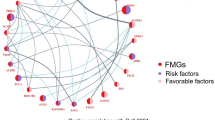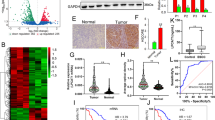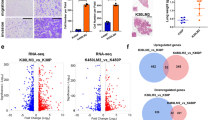Abstract
Esophageal squamous cell carcinoma (ESCC) is characterized by high aggressiveness and poor prognosis. Metabolic reprogramming is a hallmark of ESCC, with lipid metabolism frequently upregulated. It has been shown that lipid metabolism, particularly fatty acid β-oxidation (FAO), plays an essential role in energy homeostasis, membrane biosynthesis, and tumor progression. Stimulator of interferon genes (STING), a key innate immune signaling molecule, also acts as a metabolic checkpoint by inhibiting hexokinase 2, thereby limiting aerobic glycolysis and enhancing anti-tumor immune responses. In this study, we investigated the impact of STING on FAO and tumorigenesis in ESCC. We showed that the expression levels of STING were significantly reduced in ESCC compared to adjacent normal tissue. In the ESCC cell line KYSE-510, knockdown of STING significantly elevated lipid metabolites, decreased intracellular lipid droplets, and increased FAO products, whereas overexpression of STING inhibited ESCC cell proliferation and tumor progression by suppressing FAO. Targeted lipid metabolomic analyses revealed that STING interacted with carnitine palmitoyltransferase 1A (CPT1A), a key enzyme in FAO. STING promoted the ubiquitination and degradation of CPT1A by disrupting its interaction with USP15, a deubiquitinating enzyme. Treatment with the CPT1A inhibitor etomoxir (50 μM) reversed the increased FAO induced by STING depletion in KYSE-30 cells. In both in vitro and in vivo models, supplementation with palmitic acid rescued STING-induced growth inhibition, restoring tumor cell growth. In addition, STING knockout in 4-NQO-induced ESCC mice led to accelerated tumor progression, which could be mitigated by CPT1A inhibition. Our results suggest that reduced STING expression enhances FAO and promotes ESCC cell proliferation, implicating FAO suppression as a potential therapeutic strategy for ESCC.
This is a preview of subscription content, access via your institution
Access options
Subscribe to this journal
Receive 12 print issues and online access
$259.00 per year
only $21.58 per issue
Buy this article
- Purchase on SpringerLink
- Instant access to full article PDF
Prices may be subject to local taxes which are calculated during checkout









Similar content being viewed by others
Data availability
All data supporting the findings of this study are available within the manuscript and its supplementary information files.
References
Yang Z, Tian H, Chen X, Li B, Bai G, Cai Q, et al. Single-cell sequencing reveals immune features of treatment response to neoadjuvant immunochemotherapy in esophageal squamous cell carcinoma. Nat Commun. 2024;15:9097.
Morgan E, Soerjomataram I, Rumgay H, Coleman HG, Thrift AP, Vignat J, et al. The global landscape of esophageal squamous cell carcinoma and esophageal adenocarcinoma incidence and mortality in 2020 and projections to 2040: new estimates from GLOBOCAN 2020. Gastroenterology. 2022;163:649–58.e2.
Doki Y, Ajani JA, Kato K, Xu J, Wyrwicz L, Motoyama S, et al. Nivolumab combination therapy in advanced esophageal squamous-cell carcinoma. N Engl J Med. 2022;386:449–62.
Shen L, Kato K, Kim SB, Ajani JA, Zhao K, He Z, et al. Tislelizumab versus chemotherapy as second-line treatment for advanced or metastatic esophageal squamous cell carcinoma (RATIONALE-302): A randomized Phase III study. J Clin Oncol. 2022;40:3065–76.
Tharp KM, Kersten K, Maller O, Timblin GA, Stashko C, Canale FP, et al. Tumor-associated macrophages restrict CD8+ T cell function through collagen deposition and metabolic reprogramming of the breast cancer microenvironment. Nat Cancer. 2024;5:1045–62.
Hu J, Wang SG, Hou Y, Chen Z, Liu L, Li R, et al. Multi-omic profiling of clear cell renal cell carcinoma identifies metabolic reprogramming associated with disease progression. Nat Genet. 2024;56:442–57.
Meng Y, Guo D, Lin L, Zhao H, Xu W, Luo S, et al. Glycolytic enzyme PFKL governs lipolysis by promoting lipid droplet-mitochondria tethering to enhance β-oxidation and tumor cell proliferation. Nat Metab. 2024;6:1092–107.
Xiong J. Fatty acid oxidation in cell fate determination. Trends Biochem Sci. 2018;43:854–7.
Nandi I, Ji L, Smith HW, Avizonis D, Papavasiliou V, Lavoie C, et al. Targeting fatty acid oxidation enhances response to HER2-targeted therapy. Nat Commun. 2024;15:6587.
Yang T, Hui R, Nouws J, Sauler M, Zeng T, Wu Q. Untargeted metabolomics analysis of esophageal squamous cell cancer progression. J Transl Med. 2022;20:127.
Woo MS, Mayer C, Binkle-Ladisch L, Sonner JK, Rosenkranz SC, Shaposhnykov A, et al. STING orchestrates the neuronal inflammatory stress response in multiple sclerosis. Cell. 2024;187:4043–60.e30.
Gulen MF, Samson N, Keller A, Schwabenland M, Liu C, Glück S, et al. cGAS-STING drives ageing-related inflammation and neurodegeneration. Nature. 2023;620:374–80.
Xiao R, Zhang A. Involvement of the STING signaling in COVID-19. Front Immunol. 2022;13:1006395.
Sun Y, Patterson-Fortin J, Han S, Li Z, Nowicka Z, Hirohashi Y, et al. 53BP1 loss elicits cGAS-STING-dependent antitumor immunity in ovarian and pancreatic cancer. Nat Commun. 2024;15:6676.
Li J, Canham SM, Wu H, Henault M, Chen L, Liu G, et al. Activation of human STING by a molecular glue-like compound. Nat Chem Biol. 2024;20:365–72.
Liu R, Li J, Shao J, Lee JH, Qiu X, Xiao Y, et al. Innate immune response orchestrates phosphoribosyl pyrophosphate synthetases to support DNA repair. Cell Metab. 2021;33:2076–89.e9.
Vila IK, Chamma H, Steer A, Saccas M, Taffoni C, Turtoi E, et al. STING orchestrates the crosstalk between polyunsaturated fatty acid metabolism and inflammatory responses. Cell Metab. 2022;34:125–39.e8.
Shin H, Chung H. SMPDL3A links cholesterol metabolism to the cGAS-STING pathway. Immunity. 2023;56:2459–61.
Zhang L, Jiang C, Zhong Y, Sun K, Jing H, Song J, et al. STING is a cell-intrinsic metabolic checkpoint restricting aerobic glycolysis by targeting HK2. Nat Cell Biol. 2023;25:1208–22.
Akhmetova K, Balasov M, Chesnokov I. Drosophila STING protein has a role in lipid metabolism. eLife. 2021;10.
Shi Y, Wu Z, Liu S, Zuo D, Niu Y, Qiu Y, et al. Targeting PRMT3 impairs methylation and oligomerization of HSP60 to boost anti-tumor immunity by activating cGAS/STING signaling. Nat Commun. 2024;15:7930.
Wen F, Han Y, Zhang H, Zhao Z, Wang W, Chen F, et al. Epstein-Barr virus infection upregulates extracellular OLFM4 to activate YAP signaling during gastric cancer progression. Nat Commun. 2024;15:10543.
Lv G, Wang Q, Lin L, Ye Q, Li X, Zhou Q, et al. mTORC2-driven chromatin cGAS mediates chemoresistance through epigenetic reprogramming in colorectal cancer. Nat Cell Biol. 2024;26:1585–96.
Leuzzi G, Vasciaveo A, Taglialatela A, Chen X, Firestone TM, Hickman AR, et al. SMARCAL1 is a dual regulator of innate immune signaling and PD-L1 expression that promotes tumor immune evasion. Cell. 2024;187:861–81.e32.
Cho MG, Kumar RJ, Lin CC, Boyer JA, Shahir JA, Fagan-Solis K, et al. MRE11 liberates cGAS from nucleosome sequestration during tumorigenesis. Nature. 2024;625:585–92.
Ma Y, Temkin SM, Hawkridge AM, Guo C, Wang W, Wang XY, et al. Fatty acid oxidation: An emerging facet of metabolic transformation in cancer. Cancer Lett. 2018;435:92–100.
Wang X, Zhu L, Liu J, Ma Y, Qiu C, Liu C, et al. Palmitic acid in type 2 diabetes mellitus promotes atherosclerotic plaque vulnerability via macrophage Dll4 signaling. Nat Commun. 2024;15:1281.
Jia M, Chai L, Wang J, Wang M, Qin D, Song H, et al. S-nitrosothiol homeostasis maintained by ADH5 facilitates STING-dependent host defense against pathogens. Nat Commun. 2024;15:1750.
Wu J, Liu Q, Zhang X, Tan M, Li X, Liu P, et al. The interaction between STING and NCOA4 exacerbates lethal sepsis by orchestrating ferroptosis and inflammatory responses in macrophages. Cell Death Dis. 2022;13:653.
Li R, Li X, Zhao J, Meng F, Yao C, Bao E, et al. Mitochondrial STAT3 exacerbates LPS-induced sepsis by driving CPT1a-mediated fatty acid oxidation. Theranostics. 2022;12:976–98.
Hwang SM, Awasthi D, Jeong J, Sandoval TA, Chae CS, Ramos Y, et al. Transgelin 2 guards T cell lipid metabolism and antitumour function. Nature. 2024;635:1010–8.
Liu Z, Liu W, Wang W, Ma Y, Wang Y, Drum DL, et al. CPT1A-mediated fatty acid oxidation confers cancer cell resistance to immune-mediated cytolytic killing. Proc Natl Acad Sci USA. 2023;120:e2302878120.
Dai W, Xiang W, Han L, Yuan Z, Wang R, Ma Y, et al. PTPRO represses colorectal cancer tumorigenesis and progression by reprogramming fatty acid metabolism. Cancer Commun. 2022;42:848–67.
Hao X, Zhao B, Towers M, Liao L, Monteiro EL, Xu X, et al. TXNRD1 drives the innate immune response in senescent cells with implications for age-associated inflammation. Nat Aging. 2024;4:185–97.
Jiang N, Xie B, Xiao W, Fan M, Xu S, Duan Y, et al. Fatty acid oxidation fuels glioblastoma radioresistance with CD47-mediated immune evasion. Nat Commun. 2022;13:1511.
Mertens RT, Misra A, Xiao P, Baek S, Rone JM, Mangani D, et al. A metabolic switch orchestrated by IL-18 and the cyclic dinucleotide cGAMP programs intestinal tolerance. Immunity. 2024;57:2077–94.e12.
Morehouse BR, Govande AA, Millman A, Keszei AFA, Lowey B, Ofir G, et al. STING cyclic dinucleotide sensing originated in bacteria. Nature. 2020;586:429–33.
Maxwell MB, Hom-Tedla MS, Yi J, Li S, Rivera SA, Yu J, et al. ARID1A suppresses R-loop-mediated STING-type I interferon pathway activation of anti-tumor immunity. Cell. 2024;187:3390–408.e19.
Guanizo AC, Luong Q, Jayasekara WSN, de Geus ED, Inampudi C, Xue VS, et al. A STAT3-STING-IFN axis controls the metastatic spread of small cell lung cancer. Nat Immunol. 2024;25:2259–69.
Wang R, Li B, Huang B, Li Y, Liu Q, Lyu Z, et al. Gut microbiota-derived butyrate induces epigenetic and metabolic reprogramming in myeloid-derived suppressor cells to alleviate primary biliary Cholangitis. Gastroenterology. 2024;167:733–49.e3.
Tan Z, Xiao L, Tang M, Bai F, Li J, Li L, et al. Targeting CPT1A-mediated fatty acid oxidation sensitizes nasopharyngeal carcinoma to radiation therapy. Theranostics. 2018;8:2329–47.
Mo X, Niu Q, Ivanov AA, Tsang YH, Tang C, Shu C, et al. Systematic discovery of mutation-directed neo-protein-protein interactions in cancer. Cell. 2022;185:1974–85.e12.
Fu H, Mo X, Ivanov AA. Decoding the functional impact of the cancer genome through protein-protein interactions. Nat Rev Cancer. 2025;25:189–208.
Yang JY, Lei XY, He KY, Guo JR, Liu MJ, Li JQ, et al. HMGA1 drives chemoresistance in esophageal squamous cell carcinoma by suppressing ferroptosis. Cell Death Dis. 2024;15:158.
Liu MJ, Zhao Y, Li QT, Lei XY, He KY, Guo JR, et al. HMGA1 promotes the progression of esophageal squamous cell carcinoma by elevating TKT-mediated upregulation of pentose phosphate pathway. Cell Death Dis. 2024;15:541.
Meng Q, Zhang Y, Sun H, Yang X, Hao S, Liu B, et al. Human papillomavirus-16 E6 activates the pentose phosphate pathway to promote cervical cancer cell proliferation by inhibiting G6PD lactylation. Redox Biol. 2024;71:103108.
Zhao Y, Liu MJ, Zhang L, Yang Q, Sun QH, Guo JR, et al. High mobility group A1 (HMGA1) promotes the tumorigenesis of colorectal cancer by increasing lipid synthesis. Nat Commun. 2024;15:9909.
Chen L, Qiu W, Sun X, Gao M, Zhao Y, Li M, et al. Novel insights into causal effects of serum lipids and lipid-modifying targets on cholelithiasis. Gut. 2024;73:521–32.
Darrous L, Hemani G, Davey Smith G, Kutalik Z. PheWAS-based clustering of Mendelian Randomisation instruments reveals distinct mechanism-specific causal effects between obesity and educational attainment. Nat Commun. 2024;15:1420.
Guo JR, He KY, Yuan JL, An W, Yin WT, Li QT, et al. HMGA1 sensitizes esophageal squamous cell carcinoma to mTOR inhibitors through the ETS1-FKBP12 axis. Int J Biol Sci. 2024;20:2640–57.
Hale BD, Severin Y, Graebnitz F, Stark D, Guignard D, Mena J, et al. Cellular architecture shapes the naïve T cell response. Science. 2024;384:eadh8697.
He KY, Lei XY, Wu DH, Zhang L, Li JQ, Li QT, et al. Akkermansia muciniphila protects the intestine from irradiation-induced injury by secretion of propionic acid. Gut Microbes. 2023;15:2293312.
Lv H, Zong Q, Chen C, Lv G, Xiang W, Xing F, et al. TET2-mediated tumor cGAS triggers endothelial STING activation to regulate vasculature remodeling and anti-tumor immunity in liver cancer. Nat Commun. 2024;15:6.
Vicari M, Mirzazadeh R, Nilsson A, Shariatgorji R, Bjärterot P, Larsson L, et al. Spatial multimodal analysis of transcriptomes and metabolomes in tissues. Nat Biotechnol. 2024;42:1046–50.
Acknowledgements
We thank scientists in the Xu Lab for their technical support and constructive discussions. This work was supported by the National Key Research and Development Program of China (2023YFE0109800), the National Natural Science Foundation of China (Nos. 82020108024, 82400658, and 82200596), the China Postdoctoral Science Foundation (No. 2022M721014) and the Scientific and Technological Research Project of Henan Province (No. 252102311069).
Author information
Authors and Affiliations
Contributions
LZ wrote the manuscript and designed the study. LJZ, YZ, XYL, DHW, KYH, MJL, JYY, JRG, ZHJ, and ZHY performed the experiments. YPJ and ZXX contributed to the conception and writing. All authors read and approved the final manuscript.
Corresponding authors
Ethics declarations
Competing interests
The authors declare no competing interests.
Ethical approval and consent to participate
All animal procedures were approved by the Institutional Animal Care and Use Committee (IACUC) at Henan University, China, and complied with institutional guidelines. Experiments were conducted at the Laboratory Animal Center of Henan University.
Consent for publication
All authors have reviewed, approved, and consented to the submission and publication of this article.
Additional information
Publisher’s note Springer Nature remains neutral with regard to jurisdictional claims in published maps and institutional affiliations.
Supplementary information
Rights and permissions
Springer Nature or its licensor (e.g. a society or other partner) holds exclusive rights to this article under a publishing agreement with the author(s) or other rightsholder(s); author self-archiving of the accepted manuscript version of this article is solely governed by the terms of such publishing agreement and applicable law.
About this article
Cite this article
Zhang, L., Zhu, Lj., Zhao, Y. et al. STING inhibits the progression of esophageal squamous cell carcinoma by suppressing CPT1A-mediated fatty acid β-oxidation. Acta Pharmacol Sin 46, 2793–2807 (2025). https://doi.org/10.1038/s41401-025-01581-z
Received:
Accepted:
Published:
Issue date:
DOI: https://doi.org/10.1038/s41401-025-01581-z



